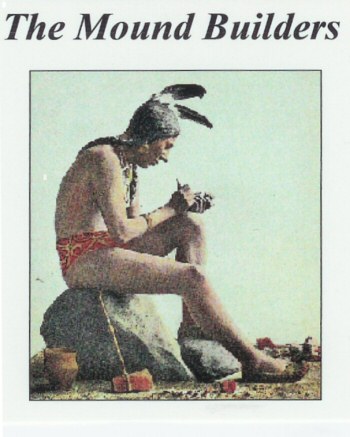Prehistoric Indians
- The Mound Builders of Arkansas
by Gary Telford
In my travels throughout Woodruff County, I have often been asked about the large mounds of dirt which exist on some of the level farm land in the area. These mounds were built by prehistoric Native Indians known as the Mound Builders.

One of my fondest memories as a young boy growing up at Blytheville, Mississippi County, Arkansas, in the early 1950's, were the many happy Saturday's I spent with some of my friends at a large Indian Mound just west of Blytheville in the middle of a large field which was always planted in cotton or beans. This mound was about 200 feet across the base and about 30 to 40 feet tall with trees and brush growing all over it. In the spring after the land had been tilled and after a good rain, we would always find arrowheads at the base of the mound. My childhood imagination would take me back to the days of the Indians that had lived there and all the work involved in the building of this great mound.
Long before the white man arrived by river in the area that we know now called Woodruff County --- possibly two thousand years ago--- a race of Indians known as Mound Builders lived here near the rivers and lakes of the area where there was good fishing and hunting and fertile soil for the seeds of corn and squash that they planted. There are many types of the dirt mounds, in all shapes and sizes, in Woodruff County. These mounds were built entirely by workers who carried loads of earth on their backs, as well as other means. They had no horses or oxen or other forms of transportation to use for help. They used tools of wood, stone or shell. Many of these mounds have several hundred tons of dirt, stone, and other materials which were built entirely by hand.
They were the ancestors of the Quapaw and the Chicasaws who were living in the county when the first French explorers paddled their canoes down the White and Cache Rivers and were the first white men to set foot in this area. The Mound Builders is not the real name of these people. Like the Pueblo Indians, it was just a name given to them because of the types of homes or type of community they lived in. The culture of the Mound Builders can be found throughout the entire Mississippi Valley which includes the states of Arkansas, Louisiana, Mississippi, Tennessee, Kentucky, Missouri and Illinois. The cultural landscape is as varied as a classic American quilt.
Little is know about the Mound Builders of so many centuries ago since there were no written records. Anthropologists have only clues to go on, bits of pottery, weapons, skeletons, woven mats and buckskin clothing that have been dug up from time to time in prehistoric burial grounds, or found in caves in the hilly areas of the state. They have learned that these early settlers were shorter than the average white man, just a little over five feet tall. Their bones show that a great many of them suffered from arthritis, especially after the age of thirty. The skulls indicate that the Mound Builders had strong jaws and good teeth and that they at times ate raw meat that had to be torn loose from the bone. They were great hunters and used flint arrowheads, spear points, and stone hammers. They fished with hooks made from bone in the rivers and lakes. It appeared to be the custom in Indian settlements for the men to clear a small area of land and for the women to plant the seeds and cultivate the crops. It is known that the earliest tribes had corn, sunflower, squash, pumpkin, and popcorn. Often the squash was dried and stored in pottery jars for use in winter. Hoes were often made from the shoulder blades of deer and other garden tools from mussel shells.
Mounds are found in many sections of Arkansas, generally in the plain or lowland areas. Some were built as bases for temples where the Sun God was worshipped. Generally they were round, but some have been found in the shape of a giant bird, or even serpents, both of which were objects of worship by this early race of men. Often the mounds were burial sites where dozens of skeletons have been unearthed.
North of Augusta from four to six miles, there are a series of small mounds. On the serial maps which the government provides farmers these mounds are easily identified. They show up as perfect circles, as round as a coin. There are several in the neighborhood of the Holly Grove Church on Highway 33 North. North of Fitzhugh is a very large mound known as Teague Mound which might possibly be of Indian origin. It is high enough to stand out above most flood waters, but so far as is known it has never been explored with pick and shovel. The age of the mounds can sometimes be determined by the depth of the skeletons and the age of trees that have taken root. Not all mounds were built by these prehistoric Indians, since the custom persisted even after the arrival of the white men.
Arrowheads, spear points, and stone knives have been found in many areas of Woodruff County. After heavy rains there is a good prospect that arrowheads can be found on the sandy knolls of farms north of Augusta.
The delta area of Woodruff County was probably much lower in the days of prehistoric Indians. Silt carried by flood waters has built up the terrain. When a rice well on the Fitzhugh farm was dug by the Wixon Brothers over twenty years ago chips from a charred cypress log were brought to the surface from a depth of 100 feet.
There is still a great mystery about the Mound Builders, and for that matter about all the prehistoric Indians who lived in Arkansas. Even before the Mound Builders who inhabited the lowlands there was another race of Indians called the Bluff or Cave Dwellers who lived in caves and shelters in the foothills of the Ozarks and then suddenly they disappeared. Historians can't decide if they were massacered in tribal wars, or if some sort of plague wiped them out. Many of their caves have been explored and their artifacts and storage vaults examined, but the mystery remains.
But perhaps the greatest mystery of all is, "How did prehistoric man come to North America?" It is assumed by most historians that the homo sapiens species originated in the valleys of Africa or perhaps in the Near East. But how did they migrate to North and South America? Some say that in antiquity the continents were much closer together and passage could have been made by dugout canoes. The most popular theory is that prehistoric tribes crossed over the Bering Straight into Alaska and then drifted south into more pleasant climates. Facial characteristics of Indians and Slavic people of Europe bear some resemblance, especially the cheek bones, but the resemblance is so faint as to be inconclusive.
Most of the mounds in Woodruff County are on privately owned land. As a result, many have been irreparably damaged or completely destroyed by modern development and looting. Indian mounds, therefore, are critically endangered cultural sites. I hope that when visiting these mounds in our county, it will help you to appreciate these irreplaceable monuments of antiquity and better understand the importance of preserving those that remain. This is a part of our great history, enjoy it!

